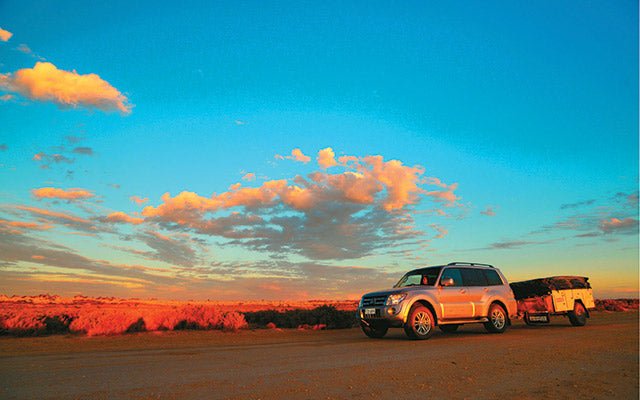
Mitsubishi Pajero VRX Di-D tow test
|
|
Time to read 3 min
|
|
Time to read 3 min
Mitsubishi has done well in owner satisfaction surveys, but is it still delivering a 4WD that can compete with those of its manufacturing counterparts with the Mitsubishi Pajero VRX Di-D?
If our extended Pajero workout is anything to go by, the answer is yes. 12 months down the track and an additional 30,000km on the odometer, the Pajero remains in fine fettle. In fact, it is one reliable workhorse and comfortable to boot.
In April 2013, when we were given the keys to a fresh Pajero VRX, it had just 2500km on the odometer. But it’s barely rested a minute since residing in Camper Trailer Australia’s Melbourne HQ long-term garage. Aside from the Camper Trailer of the Year awards event in Robe last year, the Pajero has headed up to the Vic High Country numerous times with trailer in tow, travelled to Victoria’s East Gippsland, the Great Ocean Road, all over the Mornington Peninsula and Greater Melbourne. In NSW, the Pajero headed to the South Coast, the alpine region, the Murray River near Albury, a return trip to Sydney and a stint to Mungo National Park via Swan Hill. It’s even towed a trailer boat up to the Gold Coast from Melbourne for sister publication, Trade-a-Boat.
The Pajero isn’t the newest 4WD on the road. Replacing the NS series Pajero of 2006 — a major revision of the NM Pajero and the first of the series in 1999 — the new 2009 NT series Pajero features an upgraded 3.2L diesel engine with better power and torque outputs. If you weren’t confused already, the NT series last year became the NW series, with minor spec changes. The 3.2L turbo-diesel engine is the only engine available with either five-speed manual or five-speed auto.
Our Pajero is a VRX auto at $63,990 (plus on-road costs) with the $495 metallic cool silver paint option.
The seats are very comfortable up front with acceptable side support and good under thigh support. Once you get your seat adjusted correctly, the Pajero is a comfortable long-distance tourer, with adjustable lumber support taking the pressure off your back. The driver has excellent vision forward and to the sides, but despite the tailgate-mounted spare rear sitting quite low, vision out the back is not ideal, although this is assisted somewhat by the handy reversing camera.
The Pajero has large side mirrors for good vision behind most campers and you can adapt them to see vehicles behind and also keep an eye on the trailer wheels when turning corners.
The rear seat is a family-oriented design, meaning it is quite flat. Those with children will understand this as kids can be strapped into child seats and boosters relatively easily.
The VRX is a seven-seater, with the rear two seats folding away completely under the floor of the cargo area. This means the rear space is tall, deep and unfettered. The cargo area also has good, solid tie-down points and even though side-swing doors are a bit old school, at least the Pajero’s strut-assisted tailgate has a lockout mechanism that works well on cambered roads to keep the door from slamming shut.
The Pajero eats up a slippery, bumpy goat track with such poise that you get a surprise when it occasionally bangs over a larger bump. We can’t think of many other high speed dirt tourers that do the Aussie outback as well as the Pajero. It has a docile, smooth and forgiving nature when cruising.
This ability to eat up long distances is replicated with a camper trailing behind, and the Pajero remains as solid as a rock, although it feels a bit slower and uses a bit more fuel. These are the expected outcomes when you’re lugging your home away from home behind. Importantly, braking is still strong and stability is excellent.
It was relatively miserly over the year we’ve had the Pajero. An average of 11.5L/100km for urban driving, 8.5L/100km for highway cruising (unladen) and 14.5L/100km towing around 1000kg-1500kg of camper trailer.
The worst fuel reading we achieved? A grand total of 45L slurped down over 100km when towing a camper in very challenging offroad conditions in low range. That last figure is based on a very low overall distance and hardcore, slippery tracks we hope we don’t see again. A more realistic low range average in difficult conditions would be no more than 18L/100km.
We will have to admit, the Pajero did actually have a “fail to proceed” moment. When climbing a near-vertical ball-bearing gravel track in the Victorian High Country recently. The Pajero, with a camper hitched up, just could not get traction from its H/T rubber. If it were better shod for offroad work, it would have shot up.
If that’s the worst complaint we can make about a stock-standard 4WD wagon, then that’s pretty good going. While the Pajero might not be the latest design to arrive at a vehicle showroom, it is in our experience one very accomplished, reliable 4WD tourer.
Find more tow vehicle reviews on Camper Trailer Australia and Caravan World.